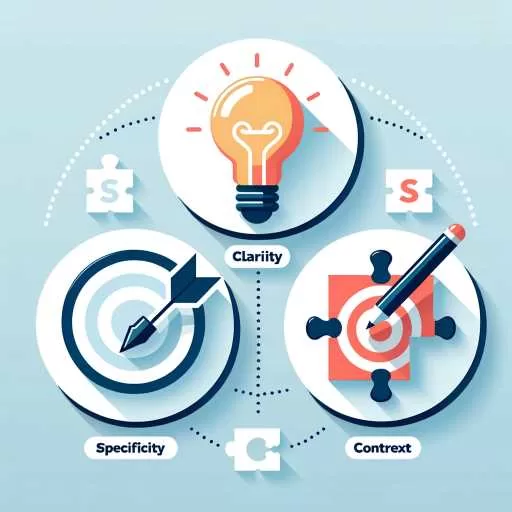Welcome to Prompt Engineering
In today’s rapidly evolving digital landscape, artificial intelligence (AI) is no longer just a buzzword but a transformative force across various sectors. However, the true potential of AI is often unlocked not just by the technology itself but by how we interact with it. This is where the art of “prompt engineering” comes into play. A skill set that is becoming increasingly important for anyone looking to harness the power of AI effectively.
At Wired Wits, we believe in demystifying AI, making it accessible and usable for everyone, regardless of their technical background. Prompt engineering, the process of crafting precise and effective inputs to generate desired outputs from AI models, stands at the heart of this mission. Whether you’re a seasoned tech enthusiast or an AI novice, mastering this art can significantly enhance your interaction with AI. Subsequently, opening up new avenues of creativity, efficiency, and innovation.
In this guide, we’ll explore the essentials of prompt engineering, why your command of the English language plays a pivotal role, and how you can use AI, like ChatGPT, to refine your prompts to perfection. Join us on this journey to not only understand but also to apply the principles of prompt engineering, making every interaction with AI a step towards mastering this cutting-edge skill.
What is Prompt Engineering?
At its core, prompt engineering is a fascinating blend of art and science, pivotal in the realm of AI and natural language processing (NLP). But what exactly does it entail? Imagine you’re having a conversation with a highly intelligent machine, like ChatGPT. The quality and specificity of your questions or prompts can significantly influence the machine’s responses. This is the essence of prompt engineering—crafting these questions or inputs so precisely that the AI responds in the most helpful, accurate, and relevant way possible.
Why is this important? In a world where AI is increasingly becoming a part of our daily lives, from recommending movies on streaming platforms to providing customer support, the ability to effectively communicate with these AI systems can greatly enhance their utility and our overall experience. For businesses, educators, content creators, and even casual users, prompt engineering is the key to unlocking the full potential of AI, ensuring that the technology not only understands but also accurately fulfills our requests and needs.
Through prompt engineering, we can steer AI towards generating creative content, tackling complex problems, and even mastering new concepts. This skill empowers us to engage with AI on a deeper level, fostering a more meaningful and productive interaction. In doing so, we transform AI from being just a tool into a collaborative partner, opening up a plethora of possibilities for innovation and creativity.
It Starts With Clear Communication with the AI

When we interact with AI models like ChatGPT, our words matter. The way we arrange them, and the context we provide—plays a significant role in how the AI understands and responds. These models are designed to parse language much like a human would. It looks at sentence construction, subtleties of word choice, and the overall context to generate relevant and accurate responses.
It’s primarily about being mindful of how you articulate your thoughts. Even with simple, straightforward language, you can achieve excellent results, provided that the prompts are clear and focused. Essentially, the key is to express your intentions as plainly as possible. Thereby avoiding any ambiguity that might inadvertently misguide the AI.
Don’t worry about your English skills, remember that proficiency exists on a spectrum, and there’s always an opportunity for improvement. More significantly, engaging with AI can serve as a valuable component of your linguistic development. By experimenting with various ways to frame your prompts and observing the AI’s reactions, you can delve into the subtleties of language and enhance your skills over time.
Moreover, the Wired Wits community is a supportive space where we learn from each other. Sharing your experiences, successes, and challenges with prompt engineering can offer valuable learning opportunities. Opportunities that not only benefit you but your fellow community members as well. Remember, every interaction with AI is a step forward in this exciting journey of discovery and learning.
Crafting Strong and Effective Prompts
Mastering the craft of prompt engineering is akin to fine-tuning a musical instrument. When done correctly, it harmonizes your intentions with the AI’s responses, creating a symphony of effective interaction. Here are some key strategies to consider when crafting your prompts:
1. Be Specific
Specificity is your best friend when interacting with AI. The more precise you are about what you’re asking, the less room there is for the AI to veer off course. For instance, instead of asking, “Tell me about dogs,” you might say, “Provide a summary of the main characteristics and care needs of Labrador Retrievers.” This clarity guides the AI to generate a focused and relevant response.
2. Provide Context
Context acts as a roadmap for the AI, helping it understand not just the ‘what’ but the ‘why’ of your prompt. Including relevant background information can significantly enhance the AI’s ability to tailor its response to your needs. For example, “As a beginner gardener in a temperate climate, what should I know about planting tomatoes?” Here, the context helps the AI customize its advice.
3. Use Clear and Concise Language
While it’s important to be detailed, brevity remains the soul of wit—even in prompt engineering. Avoid unnecessary complexity and aim for clear, straightforward language. This approach reduces the chances of misinterpretation and ensures that the AI can grasp and address your core request efficiently.
4. Set the Desired Tone and Style
If your prompt involves creative content, don’t hesitate to specify the tone, style, or even the format you’re aiming for. Whether you’re looking for a humorous blog post, a formal report, or a poetic composition, guiding the AI on the desired outcome can make a big difference in the results.
5. Iterate and Refine
Prompt engineering is not always a ‘get it right the first time’ kind of task. It often involves iteration—refining your prompts based on the AI’s responses. This process is a learning experience, helping you understand the AI’s capabilities and limitations while improving your own skills.
By incorporating these strategies, Wired Wits community members can enhance their interactions with AI, making every prompt an opportunity for success. Remember, prompt engineering is a skill, and like any skill, it gets better with practice.
Common Pitfalls in Prompt Engineering
Even the most seasoned prompt engineers can sometimes find themselves facing unexpected results. Recognizing and understanding these common pitfalls can significantly enhance your prompt crafting skills, leading to more meaningful and productive interactions with AI. Here are some of the frequent missteps to watch out for:
1. Being Too Vague or Ambiguous
One of the most common challenges in prompt engineering is the tendency to be too broad or vague in your requests. Prompts that lack specificity can lead the AI down a multitude of paths, often resulting in responses that don’t quite hit the mark. For example, a prompt like “Tell me about history” is so broad that the AI might struggle to provide a focused response. Instead, narrowing it down to “Explain the causes and effects of the American Revolution” gives the AI a clear direction.
2. Overloading with Information
While providing context is crucial, there’s a fine line between giving useful background and overwhelming the prompt with too much information. An overloaded prompt can confuse the AI, making it difficult to discern the main request. Striking a balance between essential context and brevity is key to crafting effective prompts.
3. Overcomplicating the Language
Utilizing overly complex language or specialized jargon can inadvertently obstruct the AI’s capacity to comprehend and accurately respond to your prompt. Therefore, simplicity and clarity ought to be your guiding principles in this endeavor. It’s important to remember that the primary goal is to articulate your request clearly, not demonstrate your linguistic expertise.
4. Ignoring the Model’s Limitations
It’s important to have realistic expectations about what AI, including advanced models like ChatGPT, can achieve. While AI has made significant strides, it’s not infallible and has its limitations. Understanding these boundaries can help you tailor your prompts more effectively, avoiding frustration and unmet expectations.
5. Failing to Iterate
Sometimes, the first prompt doesn’t yield the desired result, and that’s okay. The willingness to iterate and refine your prompts based on the AI’s responses is crucial. Each interaction is an opportunity to learn and improve, moving closer to mastering the art of prompt engineering.
By being mindful of these common pitfalls and adopting a thoughtful approach to prompt crafting, you can significantly improve your interactions with AI, making every prompt a step towards more effective communication.
Real-World Examples: The Good, the Bad, and the AI
To bring the principles of prompt engineering to life, let’s explore some real-world examples. These comparisons will highlight how subtle changes in phrasing can lead to markedly different outcomes. Subsequently, underscoring the importance of clarity, specificity, and context in your prompts.
Example 1: The Vague vs. The Specific
- Bad Prompt: “Write something about technology.”
- Outcome: The AI might produce a generic and broad overview of technology, touching on multiple unrelated aspects without depth or focus.
- Good Prompt: “Write a brief overview of blockchain technology and its impact on data security.”
- Outcome: This prompt leads to a focused and informative piece specifically on blockchain technology. Subsequently providing valuable insights into its implications for data security.
Example 2: Overloaded vs. Balanced
- Bad Prompt: “Tell me everything about the French Revolution, including political, social, economic aspects, key figures, global impact, and its comparison to the American Revolution.”
- Outcome: The AI might struggle to cohesively address all these elements, resulting in a scattered or overly superficial response.
- Good Prompt: “Provide an overview of the causes of the French Revolution, focusing on its political and social implications.”
- Outcome: This prompt encourages a more manageable and coherent response, allowing the AI to delve into the causes and specific implications of the French Revolution.
Example 3: Overcomplicated vs. Clear
- Bad Prompt: “Elucidate on the multifaceted repercussions of quantum computing vis-à-vis classical computing paradigms.”
- Outcome: The complex language can lead to confusion or an overly technical response that might not be accessible to all readers.
- Good Prompt: “Explain the differences between quantum and classical computing and the advantages of quantum computing.”
- Outcome: A clear and straightforward prompt results in an informative comparison that is more likely to be understood by a broader audience.
Example 4: General Inquiry vs. Targeted Market Research
- Bad Prompt: “Tell me about the current trends in the beverage industry.”
- Outcome: The AI might provide a very general overview that touches on various trends without offering deep, actionable insights.
- Good Prompt: “Analyze the growing popularity of non-alcoholic craft beers in the U.S. market over the past year and predict future trends.”
- Outcome: This specific and focused prompt leads to a detailed analysis of a niche trend. It offers valuable insights for businesses or individuals interested in this segment of the beverage industry.
Example 5: General Pet Question vs. Detailed Labrador Care Inquiry
- Bad Prompt: “Give tips on dog care.”
- Outcome: The AI might offer generic dog care advice that applies broadly, lacking breed-specific details that could be crucial for owners.
- Good Prompt: “Provide detailed care instructions for Labrador Retrievers, focusing on dietary needs, exercise routines, and health screenings.”
- Outcome: This prompt ensures a response that’s tailored to the unique needs of Labrador Retrievers. It offers practical and specific advice that’s directly applicable for owners of this breed.
These examples demonstrate that the effectiveness of your communication with AI hinges on how well you craft your prompts. By being mindful of your prompt’s structure, clarity, and specificity, you can guide the AI to produce responses that are not only relevant but also rich in content and insights.
Leveraging AI to Write Better Prompts
The journey of mastering prompt engineering doesn’t have to be a solitary one. In fact, AI itself can be a powerful ally in this process. Therefore, by engaging with AI tools like ChatGPT, you can refine your prompts, explore different phrasing options, and learn from the feedback and responses you receive. Here’s how you can leverage AI to enhance your prompt crafting skills:
1. Experiment with Variations
Don’t hesitate to experiment by rephrasing your prompts in various ways and comparing the AI’s responses. This trial and error approach can provide insights into how slight changes in wording can lead to significant differences in outcomes.
2. Use AI for Feedback
Some AI tools offer feedback on clarity, grammar, and even the potential effectiveness of your prompts. Utilizing these features can help you refine your prompts before using them for more critical tasks.
3. Analyze AI Responses
Take the time to analyze the AI’s responses to your prompts. Identify what worked well and where there might have been misunderstandings. This analysis can guide you in adjusting your approach to prompt engineering.
4. Engage in Dialogue with AI
Engaging in a back-and-forth dialogue with AI can mimic a brainstorming session, where you refine your ideas and prompts based on the AI’s feedback. This interactive process can sharpen your prompt crafting skills over time.
5. Learn from the Community
Share your experiences and learnings with the Wired Wits community or other forums. Exchanging tips and best practices with fellow AI enthusiasts can offer new perspectives and strategies in prompt engineering.
By viewing AI as a tool for collaboration rather than just a service provider, you can transform your interactions into learning opportunities, continuously improving your ability to craft effective prompts.
Leveraging AI to Clarify and Refine Ideas
One of the most powerful aspects of ChatGPT and similar AI tools is their ability to act as a sounding board for your ideas, helping to bring clarity to complex thoughts. This is particularly beneficial if you are like me, and find yourself struggling to articulate exactly what you want to say. Here’s how you can use AI to untangle your thoughts and craft effective prompts:
Using AI as a Thought Partner
- Start by expressing your thoughts or objectives to the AI in their raw, unfiltered form, no matter how scattered or jumbled they might seem.
- Ask the AI to summarize or clarify your input, essentially requesting it to create a more focused and coherent prompt based on your initial thoughts.
- Use the refined prompt provided by the AI as a springboard for further exploration or as the final version for more detailed inquiries.
This iterative process allows you to leverage the AI’s natural language understanding capabilities to distill your thoughts into clear, actionable prompts. It’s like having a conversation with a partner who’s exceptionally good at reading between the lines and helping you find the essence of what you’re trying to say.
Example:
- Initial Input: “I’m trying to figure out how to make my blog more engaging. I’ve got ideas about visuals, interactive content, maybe some quizzes, but it’s all over the place.”
- AI-Refined Prompt: “Can you provide strategies for increasing blog engagement through visuals, interactive content, and quizzes, ensuring a cohesive user experience?”
- Outcome: The AI helps organize and refine your scattered thoughts into a clear, focused prompt that can then be used to generate detailed and actionable advice.
By embracing AI as a collaborative tool in this way, you not only enhance your prompt engineering skills but also streamline the process of turning your ideas into well-defined projects or queries. This approach underscores the reciprocal nature of human-AI interaction, where each party contributes to achieving greater clarity and purpose.
Interactive Challenge: Put Your Skills to the Test

Now that we’ve explored the ins and outs of prompt engineering, it’s time to put your new skills to the test. We’re excited to introduce the Wired Wits Prompt Engineering Challenge! Here’s how you can participate:
- Firstly: Choose a topic or question you’re curious about.
- Secondly: Craft a prompt using the techniques and strategies discussed in this guide.
- Thirdly: Share your original prompt and the AI’s response in the comments below or on our subreddit r/WiredWits. If you’re comfortable, include a brief reflection on the process—what you learned, any surprises, and how you might refine your approach in the future.
This challenge is not just about testing your skills; it’s an opportunity to learn from each other, share insights, and collectively enhance our ability to communicate with AI. Whether you’re a beginner or have some experience, every contribution is valuable and a chance to grow.
So, dive in, experiment, and see where your prompts take you! The Wired Wits community is a supportive space for exploration and learning, and we can’t wait to see the innovative and creative ways you’ll engage with AI. Let’s transform our understanding of prompt engineering into actionable skills that empower us all.
Wrapping Up This Exploration of Prompt Engineering
As we wrap up our journey through the art of prompt engineering, remember that mastering this skill is a continuous process of learning, experimenting, and refining. The beauty of AI, particularly tools like ChatGPT, lies in their vast potential to amplify our creativity, solve complex problems, and explore new horizons—all of which starts with the prompts we craft.
Whether you’re a seasoned pro or just starting, each prompt is an opportunity to hone your skills, deepen your understanding, and engage with AI in more meaningful ways. And remember, the Wired Wits community is here to support you every step of the way. Together, we can demystify AI, making it an accessible and valuable tool for everyone.
Come Join the Wired Wits Community Challenge
Finally, we turn the spotlight to you, the innovative minds of the Wired Wits community. Go ahead and take the leap to participate in the Prompt Engineering Challenge. Then, share your innovative prompts, valuable insights, and unique experiences. By doing so, we can collectively foster a vibrant space of collaboration and learning. This inclusive environment will enable everyone, ranging from AI novices to seasoned enthusiasts, to thrive and grow.
But why stop there? Dive deeper into the world of AI with our resources, join the conversation r/wiredwits, and don’t forget to sign up for our newsletter for regular updates, community highlights, and more challenges like this. If you have questions, you can head over to the Wits Watercooler and submit your question. Note, your first name only, question and the response may be spotlighted in a future newsletter. We are continually updating our glossary of technical terms so visit Decoding Tech Jargon glossary.
Your journey with AI is just beginning, and the possibilities are as limitless as your imagination. Let’s embark on this exciting adventure together, crafting prompts that not only communicate with AI but also unlock the full spectrum of its potential.

